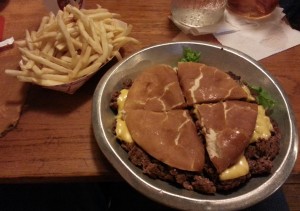You’ve done your homework and are seriously engaged in a fat loss endeavor. You’re probably tracking your food intake — you know how many calories you will eat in a given day and the macronutrient breakdown. If that applies to you, then you will understand what I’m about to say:
The week is humming along. You’re hitting those macros, but you can feel it — looming in the distance. This is an evil presence, sharpening its claws and threatening to tear your diet apart. You are going to be eating… OUT.
Maybe there is a work function. Perhaps you scored a date (good job!), or you just have a life on Fridays. Whatever the reason, it will come, and it will test you. For the unprepared, it can pose an extra hurdle to fat loss. Don’t you have enough of those already?
Of course, this is not a problem if you’re going to a chain restaurant; most have full nutrition information available. Just plan early what you will eat at the restaurant, and you’ll know what macros you have to play with for the rest of the day. Done deal.
Let’s be honest, though: chain restaurants are never going to beat individual establishments. Guys, do NOT take a girl to Chili’s. Just don’t.
You can almost guarantee a single establishment won’t provide nutrition information. I wish they did, but it’s expensive to get food tested and most restaurants are running on pretty thin profit margins as it is. Of course, they could tell you the contents of every dish, but then they’d be giving away trade secrets. Unless you want to boycott some seriously tasty eats, here are my tips for counting calories in a real restaurant:
- Check out the menu ahead of time. Most often, you know where you’ll be eating by at least the night before1. Find the website and see what’s on the menu. If you plan ahead of time to have the grilled chicken instead of pizza and french fries, you’re more likely to stick to that decision. Don’t be waylaid by the wiles of sneaky mashed potatoes you weren’t expecting. If you wait to decide how far things are going to go until you’re already in the back seat… well good luck with that. Once you know the menu:
- Pick something you can fit into your diet. You don’t always have to get Tilapia. I’m planning on having Chicken & Waffles this very night, but I’ve worked it into my macros for the day. Sometimes, you will have to make sacrifices. I’ll give you an example: this weekend, I went to a popular local Mexican joint for a friend’s birthday. The only thing I could possibly order without blowing away my carb count was Fajitas. Here was the description: “Grilled chicken breast, rice, beans, guacamole, flour tortillas, pico-de-gallo, chips and hot sauce.” Clearly, that wouldn’t cut it, so I modified the menu. I asked for chicken fajitas without anything else except refried beans. Oh, and I can already hear you screaming, “Well how do I know if I can fit it into my diet if there is no nutrition info?!?” I’m so glad you asked.
- Find similar foods. From this weekend’s example: I ball-parked the chicken at roughly 8 oz. Then, I recorded it as John Soules Chicken Fajita meat, for which I *do* have nutrition information. I estimated the refried beans as nearly a cup, and recorded them as 0.9 cups of canned refried beans. I gauged the amount of sauteed onions and sauteed peppers and found them(fat included in cooking) in my tracking app as well. If you’re worried about accuracy, purposefully overestimate on the amounts to give yourself a cushion. Maybe it won’t be exact, but I can guarantee it is close enough for tracking purposes.
- Learn to use a food scale. If you don’t have a food scale, stop reading this and get one. I currently use this from Amazon. A good food scale will increase accuracy when you are preparing your own food. I weigh out my lucky charms, chicken, and basically anything that is not liquid. Sometimes I even weigh liquids too (almond milk, etc). More to the topic at hand, though — regular use of a food scale will make you pretty accurate when ball-parking food amounts. I weigh out chicken almost every day, so I know what 4 oz of chicken looks like. Of course, you could take a scale with you, but you risk your friends/date/co-workers judging you as insane. Until such day as accurate food tracking becomes socially acceptable, you may be forced to hone your estimation skills. Finally, even if yours are undeveloped, you can:
- Call ahead. Maybe you’ve found an item or two on the menu you can work with, but you don’t know whether you’re dealing with a 4 oz cut of steak or 8. If you call before things get busy, most places will try and find the information for you. Sometimes you’ll get lucky and they’ll actually have nutrition information available that wasn’t advertized. (Once, Texadelphia printed me out a whole sheet that wasn’t on their website. Score!) Ask for whatever information you need to feel good about your choice. If the restaurant wants your business, they will oblige.
Hopefully, these tips will give you a fighting chance when you’re eating out. It’s not easy, but you can definitely tip the odds toward your success with a little work. Bon appetit, and good luck!
